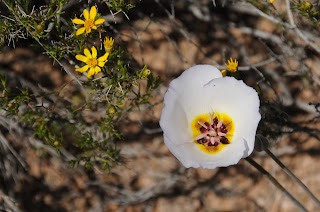Forest Service road maps can burn the eyeballs. Black
tentacles sprawled across paper maps or smart devise screens bearing nondescript
numbers and letters give clues about road conditions, where you can take a
motorized vehicle and nearby towns and landmarks.
But, where do the roads go? Why would a road end abruptly at no
particular destination? The best way to find answers is to park and hoof it.
Forest Road 9365R north of the town of Strawberry is a good
one to try because its terminus-- marked only by an “X” on most maps-- is a memorable
sight.
Located on the Mogollon Rim just outside of Fossil Springs Wilderness
Area, the road begins as a typical backwoods Jeep route. On a base of sandstone,
smothered in a forest of Alligator junipers and Ponderosa pines, hikers pass through a pinecone cluttered corridor bolstered by massive rock slabs. At
about a mile into the trek, the road meets a clearing with wide views of
Deadman Mesa on the border of Coconino and Tonto National Forests. At this
point, it’s possible to spot the hike’s objective—a basalt knob poking up from the edge of a bluff off to the right. From here, the route heads downhill passing a mucky stock tank and barbed wire relics. After a brief traipse through a low saddle, the rock underfoot changes from tawny sandstone to ashen volcanic boulders and pebbles. Here, the degraded path goes uphill on a juniper-populated slope overlooking Calf Pen Canyon. Fossil Creek flows through the colorful, rugged gorge, but you’d be hard-pressed to see it from this vantage point. On clear days, Flagstaff’s San Francisco Peaks are visible on the horizon.
 |
| View from Nash Point |
 |
| Calf Pen Canyon |
From the Calf Pen vista, the highpoint of the hike stands
out as a wall of lichen-encrusted steel-gray basalt at road’s end. Nash Point
rises to 6546 feet at the edge of Gila and Coconino Counties. A moderate
scramble to its summit reveals enhanced views of Calf Pen and the Fossil
Springs area. Although it’s not clear why anybody would have built a road to
such an odd place, the jumbled perch provides satisfying closure and animates an
uninspiring “X” on a map.
 |
| Views along FR 9365R |
 |
| Nash Point. PHOTO: Randy Cockrell (used with his permission) |
LENGTH: 5.3 miles round trip
RATING: moderate
ELEVATION: 6250' - 6526'
GETTING THERE:
From the junction of State Routes 260/87 in Payson, go 17.5 miles
north on SR87 to Fossil Creek Road in the town of Strawberry. Continue on SR 87
for another 2.2 miles to just before milepost 273 and turn left into a dirt
parking lot.
Pass through the gate (close it behind you) and hike the road.
At the 0.25-mile point, continue straight at a fork and at the 0.5-mile, veer
right and a second fork. From here, the route is obvious.
Coconino National Forest Motor Vehicle Use Maps, April 2017 Updates:












